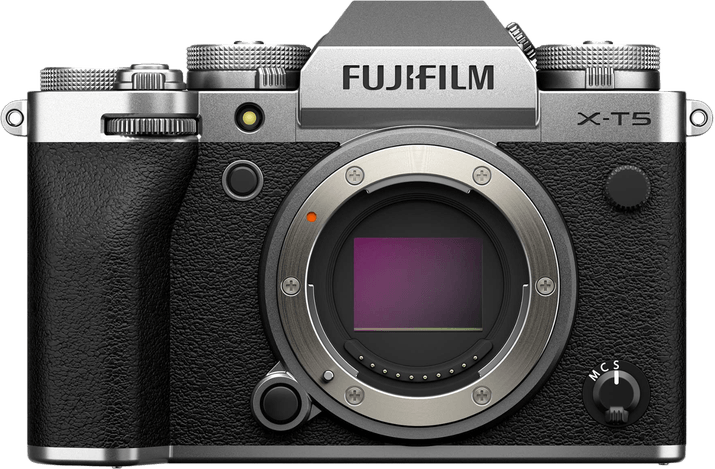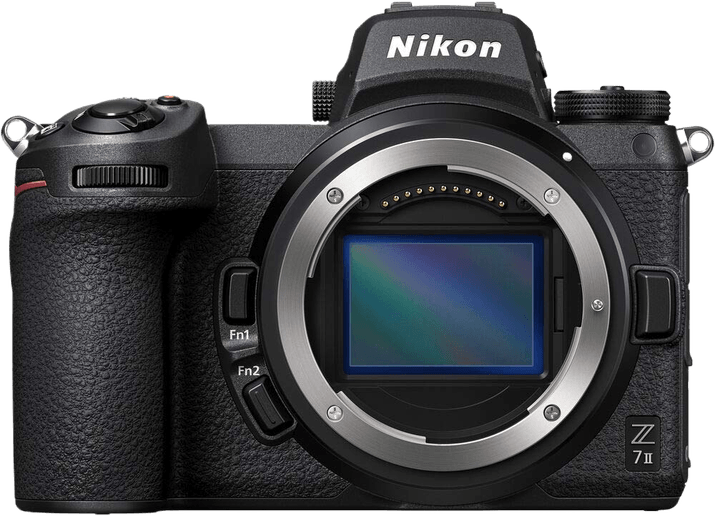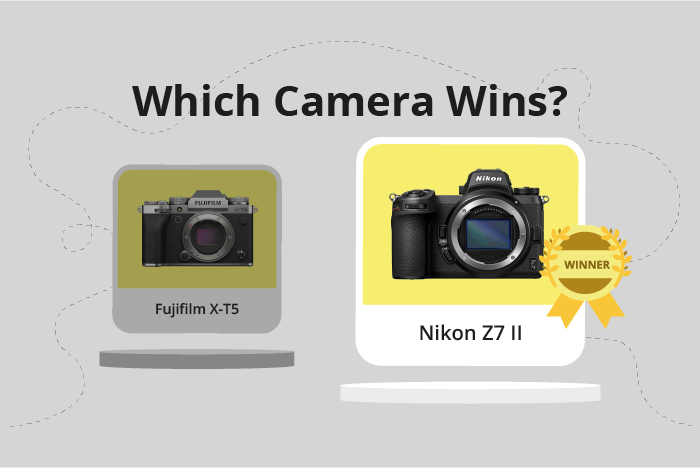Fujifilm X-T5 vs Nikon Z7 II Comparison
Fujifilm X-T5

Nikon Z7 II

The Nikon Z7 II takes the lead with a score of 85/100, while the Fujifilm X-T5 follows closely with 81/100. Both cameras are mirrorless and share similarities in size, with the Nikon Z7 II measuring 134 x 101 x 70mm and the Fujifilm X-T5 at 130 x 91 x 64mm.
The Nikon Z7 II excels due to its higher score, despite being released in 2020 with a launch price of $3399. On the other hand, the Fujifilm X-T5, released in 2022, has a more affordable launch price of $1699. However, the Fujifilm X-T5 has a lighter weight of 557g compared to the Nikon Z7 II’s 705g, making it more portable.
Considering each point, the Nikon Z7 II outperforms the Fujifilm X-T5 in terms of overall score, but the Fujifilm X-T5 offers a more budget-friendly and lightweight option for photographers.
Fujifilm X-T5 vs Nikon Z7 II Overview and Optics
The Nikon Z7 II takes the lead in optics with a score of 86/100, while the Fujifilm X-T5 follows closely with a score of 81/100. Both cameras share several common specifications, including CMOS sensors, image stabilisation, and lens mounts specific to their respective brands.
The Nikon Z7 II outperforms the Fujifilm X-T5 in terms of megapixels and sensor size. With a 45.75-megapixel sensor, the Nikon Z7 II captures more detail than the 40-megapixel Fujifilm X-T5. Additionally, the Nikon Z7 II has a full-frame sensor, which offers better low-light performance and a shallower depth of field compared to the Fujifilm X-T5’s APS-C sensor. The DXOMARK score of 100 for the Nikon Z7 II’s sensor further highlights its superior image quality.
On the other hand, the Fujifilm X-T5 has a faster shooting speed of 15 frames per second, compared to the Nikon Z7 II’s 10 frames per second. This makes the X-T5 more suitable for capturing fast-moving subjects and action photography. However, this advantage is not enough to surpass the Nikon Z7 II’s overall better image quality.
The Nikon Z7 II’s higher score and better performance in key optical aspects make it the preferred choice for photographers seeking the best image quality. The Fujifilm X-T5, while not as strong in image quality, offers an advantage in shooting speed, making it a viable option for those prioritising action photography. Both cameras have their strengths, and the choice ultimately depends on the specific needs and preferences of the photographer.
Fujifilm X-T5 vs Nikon Z7 II Video Performance
The Nikon Z7 II outperforms the Fujifilm X-T5 in video capabilities, scoring 91/100 compared to the X-T5’s 87/100. Both cameras share some common features, such as built-in time-lapse functionality and a maximum video frame rate of 60fps. However, there are key differences that set the Nikon Z7 II apart, as well as some advantages to the Fujifilm X-T5.
The Nikon Z7 II surpasses the X-T5 with its higher video resolution of 4K (3840×2160) compared to the X-T5’s 6K (6240×4160). This results in sharper, more detailed footage, making the Z7 II the better choice for professional videographers and filmmakers. Additionally, the Z7 II boasts a higher maximum video frame rate of 120fps, which allows for smoother slow-motion footage and greater creative flexibility in post-production.
On the other hand, the Fujifilm X-T5 does have some benefits in its video capabilities. Its 6K video resolution offers more detail and higher image quality, which can be advantageous for certain projects or when shooting in challenging lighting conditions. However, the X-T5’s lower video score and maximum frame rate of 60fps make it less versatile than the Nikon Z7 II.
In comparing the video capabilities of the Fujifilm X-T5 and the Nikon Z7 II, the Z7 II emerges as the better choice for most users due to its higher video score, 4K resolution, and faster maximum frame rate. The X-T5’s 6K resolution may be appealing for specific purposes, but its overall performance is not as strong as the Z7 II’s. As a result, the Nikon Z7 II is the recommended camera for those seeking superior video performance.
Fujifilm X-T5 vs Nikon Z7 II Features and Benefits
The Nikon Z7 II wins the features comparison with a score of 87/100, while the Fujifilm X-T5 scores 85/100. Both cameras share several specifications, making them comparable in many aspects. They both have a touchscreen, flip screen, WiFi, and Bluetooth connectivity. Neither camera has GPS functionality.
The Nikon Z7 II is better in terms of screen size and resolution. It features a 3.2-inch screen with a resolution of 2,100,000 dots, providing clearer and larger image previews. The Fujifilm X-T5 has a slightly smaller 3-inch screen with a lower resolution of 1,840,000 dots. The larger screen and higher resolution of the Nikon Z7 II make it more convenient for photographers to review and compose their shots.
The Fujifilm X-T5 does not outperform the Nikon Z7 II in any specific feature. However, it still offers a high-quality experience with its 3-inch touchscreen, flip screen, WiFi, and Bluetooth connectivity. While it may not be better than the Nikon Z7 II, it is still a solid choice for photographers looking for a reliable camera with these features.
Taking into consideration the scores and specifications, the Nikon Z7 II is the superior camera in terms of features. Its larger screen size and higher resolution provide a more enjoyable experience for photographers when reviewing and composing images. The Fujifilm X-T5, while not better than the Nikon Z7 II, remains a reliable option with its similar features. Ultimately, photographers should choose the camera that best meets their specific needs and preferences.
Fujifilm X-T5 vs Nikon Z7 II Storage and Battery
The Fujifilm X-T5 outperforms the Nikon Z7 II in storage and battery, scoring 76/100 compared to 71/100. Both cameras have dual memory card slots and support USB charging. They also accept SD cards, with the X-T5 being UHS-I compatible and the Z7 II being UHS-II compatible. The Z7 II additionally accepts CFexpress Type B and XQD cards.
The X-T5’s advantage lies in its superior battery life, providing 580 shots per charge with its NP-W235 battery, while the Z7 II offers 420 shots with its EN-EL15c battery. This allows X-T5 users to shoot for longer periods without needing to replace or recharge the battery.
On the other hand, the Nikon Z7 II has the advantage of using faster UHS-II compatible SD cards and supporting CFexpress Type B and XQD cards, which may benefit photographers who require high-speed storage for their workflow.
Considering these factors, the Fujifilm X-T5 is the better choice for those prioritizing battery life, while the Nikon Z7 II caters to those who value faster storage options.
Fujifilm X-T5 vs Nikon Z7 II – Our Verdict
Are you still undecided about which camera is right for you? Have a look at these popular comparisons that feature the Fujifilm X-T5 or the Nikon Z7 II:

